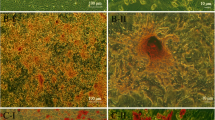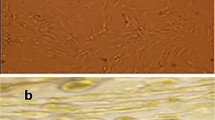Abstract
Background
The therapeutic potential of adult stem cells in the treatment of chronic diseases is becoming increasingly evident. In the present study, we sought to assess whether treatment with mesenchymal stem cells (MSCs) efficiently retards progression of chronic renal failure (CRF) when administered to experimental models of less severe CRF.
Methods
We used two renal mass reduction models to simulate different stages of CRF (5/6 or 2/3 mass renal reduction). Renal functional parameters measured were serum creatinine (SCr), creatinine clearance (CCr), rate of decline in CCr (RCCr), and 24-h proteinuria (PT24h). We also evaluated renal morphology by histology and immunohistochemistry. MSCs were obtained from bone marrow aspirates and injected into the renal parenchyma of the remnant kidneys of both groups of rats with CRF (MSC5/6 or MSC2/3).
Results
Animals from groups MSC5/6 and CRF2/3 seemed to benefit from MSC therapy because they showed significantly reduction in SCr and PT24h, increase in CCr and slowed the RCCr after 90 days. Treatment reduced glomerulosclerosis but significant improvement did occur in the tubulointerstitial compartment with much less fibrosis and atrophy. MSC therapy reduced inflammation by decreasing macrophage accumulation proliferative activity (PCNA-positive cells) and fibrosis (α-SM-actin). Comparisons of renal functional and morphological parameters responses between the two groups showed that rats MSC2/3 were more responsive to MSC therapy than MSC5/6.
Conclusion
This study showed that MSC therapy is efficient to retard CRF progression and might be more effective when administered during less severe stages of CRF.




Similar content being viewed by others
References
Romagnani P, Kalluri R. Possible mechanisms of kidney repair. Fibrogenesis. Tissue Repair. 2009;26:1–10.
Caldas HC, Fernandes IM, Gerbi F, Souza AC, Baptista MA, Ramalho HJ, Kawasaki-Oyama RS, Goloni-Bertollo EM, Pavarino-Bertelli EC, Braile DM, Abbud-Filho M. Effect of whole bone marrow cell infusion in the progression of experimental chronic renal failure. Transplant Proc. 2008;40:853–5.
Cavaglieri RC, Martini D, Sogayar MC, Noronha IL. Mesenchymal stem cells delivered at the subcapsule of the kidney ameliorate renal disease in the rat remnant kidney model. Transplant Proc. 2009;41:947–51.
Roessger A, Denk L, Minuth WW. Potential of stem/progenitor cell cultures within polyester fleeces to regenerate renal tubules. Biomaterials. 2009;30:3723–855.
Semedo P, Correa-Costa M, Cenedeze MA, Malheiros DM, Reis MA, Shimizu MH, Seguro AC, Pacheco-Silva A, Saraiva Camara NO. Mesenchymal stem cells attenuate renal fibrosis through immune modulation and remodeling properties in a rat remnant kidney model. Stem Cells. 2009;27:3063–73.
Alexandre CS, Volpini RA, Shimizu MH, Sanches TR, Semedo P, Jura DIVL, Câmara NO, Seguro AC, Andrade L. Lineage-negative bone marrow cells protect against chronic renal failure. Stem Cells. 2009;27:682–92.
Choi S, Park M, Kim J, Hwang S, Park S, Lee Y. The role of mesenchymal stem cells in the functional improvement of chronic renal failure. Stem Cells Dev. 2009;18:521–9.
Gabizon D, Goren E, Shaked U, Averbukh Z, Rosenmann E, Modai D. Induction of chronic renal failure in the mouse: a new model. Nephron. 1985;40:349–52.
Szabo AJ, Muller V, Chen GF, Samsell LJ, Erdely A, Baylis C. Nephron number determines susceptibility to renal mass reduction-induced CRF in Lewis and Fisher 344 rats: implications for development of experimentally induced chronic allograft nephropathy. Nephron Dial Transplant. 2008;23:2492–5.
Hishikawa K, Fujita T. Stem cells and kidney disease. Hypertens Res. 2006;29:745–9.
Hostetter TH. Progression of renal disease and renal hypertrophy. Annu Rev Physiol. 1995;57:263–78.
Caldas HC, Fernandes IM, Kawasaki-Oyama RS, Baptista MA, Plepis AM, Martins VA, Coimbra TM, Goloni-Bertollo EM, Braile DM, Abbud-Filho M. Effect of stem cells seeded onto biomaterial on the progression of experimental chronic kidney disease. Exp Biol Med. 2011;236:746–54.
Pittenger MF, Mackay AM, Beck SC, Jaiswal RK, Douglas R, Mosca JD, Moorman MA, SimonettI DW, Craig S, Marshak DR. Multilineage potential of adult human mesenchymal stem cells. Science. 1999;5411:143–7.
Vogelbacher R, Wittmann S, Braun A, Daniel C, Hugo C. The mTOR inhibitor everolimus induces proteinuria and renal deterioration in the remnant kidney model in the rat. Transplantation. 2007;84:1492–9.
Veniant M, Heudes D, Clozel JP, Bruneval P, Menard J. Calcium blockade versus ACE inhibition in clipped and unclipped kidneys of 2K-1C rats. Kidney Int. 1994;46:421–9.
Curtis JJ, Rakowski TA, Argy WP Jr, Schreiner GE. Evaluation of percutaneous kidney biopsy in advanced renal failure. Nephron. 1976;17:259–69.
Coimbra TM, Janssen U, Grone HJ, Ostendorf T, Kunter U, Schmidt H, Brabant G, Floege J. Early events leading to renal injury in obese Zucker (fatty) rats with type II diabetes. Kidney Int. 2000;57:167–82.
Remuzzi A, Gagliardini E, Sangalli F, Bonomelli M, Piccinelli M, Benigni A, Remuzzi G. ACE inhibition reduces glomerulosclerosis and regenerates glomerular tissue in a model of progressive renal disease. Kidney Int. 2006;69:1124–30.
Walker MR, Patel KK, Stappenbeck TS. The stem cell niche. J Pathol. 2009;217:169.
Herrera MB, Bussolati B, Bruno S, Fonsato V, Romanazzi GM, Camussi G, Fonsato V, Romanazzi GM, Camussi G. Mesenchymal stem cells contribute to the renal repair of acute tubular epithelial injury. Int J Mol Med. 2004;14:1035–41.
Morigi M, Imberti B, Zoja C, Corna D, TomasonI S, Abbate M, Rottoli D, Angioletti S, Benigni A, Perico N, AlisoN M, Remuzzi G. Mesenchymal stem cells are renotropic, helping to repair the kidney and improve function in acute renal failure. J Am Soc Nephrol. 2004;15:1794–804.
Duffield JS, Bonventre JV. Kidney tubular epithelium is restored without replacement with bone marrow-derived cells during repair after ischemic injury. Kidney Int. 2005;68:1956–61.
Acknowledgments
This work was supported by the Coordination of Improvement of Higher Education Personnel (CAPES) and FAMERP/FUNFARME.
Conflict of interest
All the authors declared no competing interests.
Author information
Authors and Affiliations
Corresponding author
About this article
Cite this article
Caldas, H.C., de Paula Couto, T.A.P., Fernandes, I.M.M. et al. Comparative effects of mesenchymal stem cell therapy in distinct stages of chronic renal failure. Clin Exp Nephrol 19, 783–789 (2015). https://doi.org/10.1007/s10157-015-1079-1
Received:
Accepted:
Published:
Issue Date:
DOI: https://doi.org/10.1007/s10157-015-1079-1




